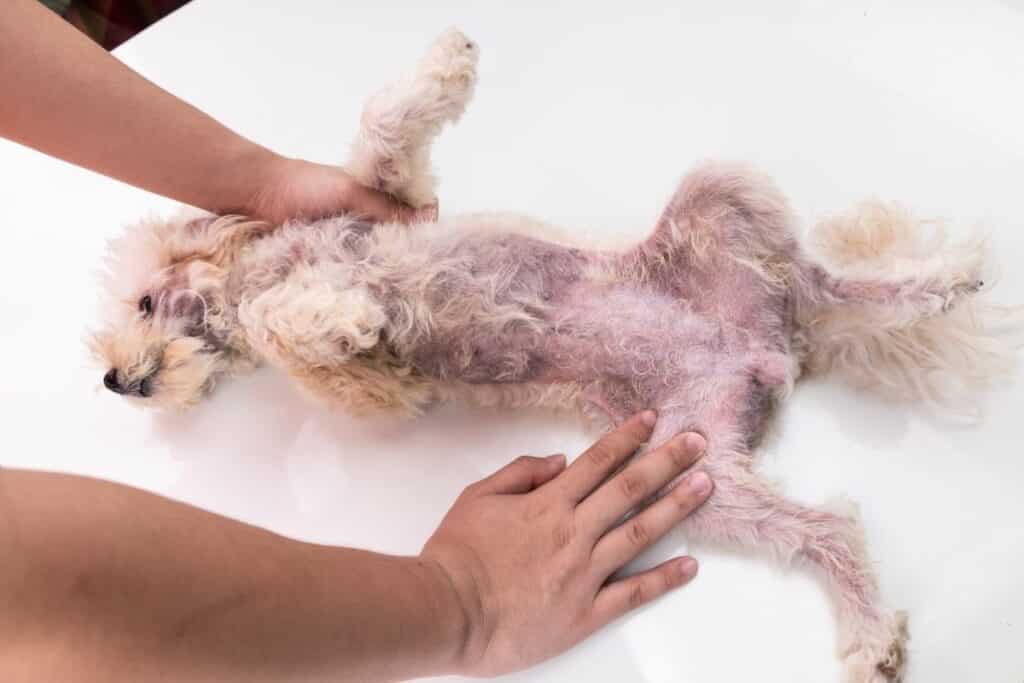If you’ve noticed your dog itching their body more than usual, redness, irritation, and flaky skin are all signs of a possible yeast infection.
Yeast infections can develop all over a dog’s body, especially in loose areas of skin and ears. But, what exactly is a yeast infection, and how can you treat it?

In this guide, we’ll take a closer look at the main causes of yeast infections in dogs, the symptoms to keep an eye out for, and the most effective methods of treatment. We’ll also look to answer a few of the frequently asked questions.
What Causes Yeast Infections In Dogs?
Yeast infections can be caused by a multitude of factors. Dogs with an underactive immune system, for example, are prone to yeast infections due to the danger of an allergic reaction, whereas dogs with an overactive immune system are also susceptible to yeast infections.
Malassezia is a form of yeast which naturally lives on the skin of a dog, as well as in their ears and anal sacs. This type of yeast is kept in check when a dog has a healthy immune system, but when Malassezia grows out of control, it can irritate the skin and lead to yeast dermatitis (inflammation).
It’s worth noting that some breeds of dog are more susceptible to yeast infections than others. These include Poodles, Shih Tzus, Basset Hounds, Dachshunds, Chihuahuas, Spaniels, German Shepherds, and Golden Retrievers.
However, these breeds aren’t the only dogs who can develop a yeast infection. In fact, any pooch can get a yeast infection if something lowers their immune system and affects the natural balance of their skin.
Listed below are a few of the other common causes that can often cause yeast infections in dogs.
Allergens – as touched upon above, allergens such as pollen, dust, mold, and even certain foods can all lead to yeast infections. Furthermore, some dogs can suffer an allergic reaction to the yeast itself.
Environment – the growth of yeast can be facilitated by certain environments. For example, yeast typically thrives in moist and humid areas.
Loose Skin – excess skin folds are a prime site for yeast growth. Therefore, it’s often common in dogs who have floppy ears.
Other Medical Conditions – some underlying medical conditions like diabetes and seborrhea oleosa can create an environment which promotes the growth of harmful yeast.
Signs And Symptoms Of A Yeast Infection
If you suspect your pooch has a yeast infection, there are lots of signs and symptoms to look out for. Listed below are the three areas which are most commonly affected by an overgrowth of yeast.
Skin
Yeast can develop pretty much anywhere on a dog’s skin, but it’s most commonly seen in areas which are moist. The affected skin is typically red, itchy, greasy, irritated, or flaky. Hair loss is also a possibility.
It’s worth noting that if the yeast infection is chronic, there’s every chance that a dog’s skin will darken in color and become notably thicker. Furthermore, the growth of yeast on a dog’s face or mouth can lead to extreme face rubbing and itching.
Ears
Another area on a dog’s body which is commonly impacted by an overgrowth of yeast are the ears. The most obvious sign is redness, but there are lots of other signs and symptoms to consider such as brown discharge, matted hair, and a sweet or musty scent.
Yeast infections in this area of the body can be extremely itchy. So, be sure to look out for your pooch constantly scratching their ear or excessively rubbing their head against an object.
Paws
If your dog has a yeast infection on their paws, this area will typically be red, irritated, and incredibly itchy. The underside of a dog’s paws is the area which is most commonly affected, although yeast can develop anywhere on the paws.
Moreover, dogs that have a yeast infection on their paws will typically lick their paws more than usual to provide relief from the irritation. It’s also not uncommon for dogs to experience hair loss in this area.
Treatment Of Yeast Infections

If you suspect that your dog has a yeast infection, it’s important to take them to a vet as soon as possible. This way, you’ll be able to identify the cause of the problem early on, and give your pooch the best chance of making a full recovery.
There are two main types of treatment for dogs suffering with a yeast infection. If the infection is relatively mild and limited to just a single area, a topical treatment such as a shampoo might be enough.
However, if the yeast infection is serious and widespread on your dog’s body, there’s every chance that your pooch will require an oral medication like antifungal pills. It’s worth noting that some vets recommend a combination of both treatments.
In terms of preventing the condition, there are a few effective home remedies you can try. These include cleaning your dog’s ears regularly, brushing their hair, drying them thoroughly after contact with water, and maintaining a healthy diet.
Frequently Asked Questions
What’s The Difference Between Ear Mites And Yeast Infections In Dogs?
Ear mites are a common problem for dogs, especially those that live in kennels or boarding facilities. They’re very small and can be difficult to see with the naked eye. While they don’t cause any kind of significant harm to your pooch, they can lead to ear irritation.
Are Yeast Infections In Dogs Contagious For Other Pets?
No, if your pooch has a yeast infection, these cells can’t be transmitted to another pet, even if they’re regularly in contact with one another. Just be mindful that a yeast infection can often lead to secondary bacterial infections, and these may be contagious to other pets.
Is It Expensive To Treat Yeast Infections In Dogs?
The average cost of treating a yeast infection in dogs is roughly $150 – $200 per month. This includes the cost of medications, in addition to the time spent administering them at home.
Is There A Cure For Yeast Infection In Dogs?
While it can’t be considered a 100% definite cure, the most effective treatment for yeast infections is antifungal medication. It’s also a good idea to keep your dog as clean and dry as possible. Therefore, bathe them regularly, particularly after they go out into the rain or snow.
The Bottom Line
To conclude, yeast infections are a relatively common skin concern for dogs and can often lead to severe discomfort and a range of secondary conditions. Therefore, it’s important to identify the root cause of the infection and treat it promptly.
Hopefully, after reading the information in this guide, you’ll be in a much stronger position to deal with the possibility of your dog developing a yeast infection. Good luck!
- What Dog Breeds Have Pink Skin? - March 24, 2023
- What Are the Most Inspiring Dog Breeding Quotes? - March 20, 2023
- Can Pheromone Spray Help Improve Dog Breeding Results? - March 19, 2023








